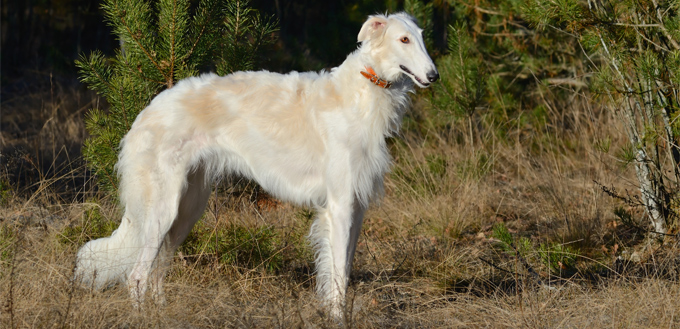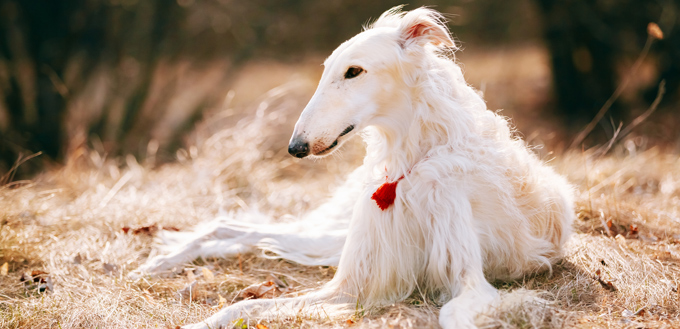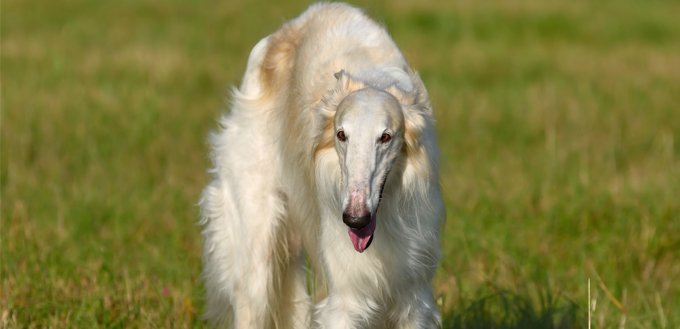Long considered as the glamour kings and queens of the venerable sighthounds, the Russian Wolfhound or Borzoi is inarguably one of the most luxurious- and elegant-looking hounds on the planet. This large yet super-slender cousin of the Greyhound has always been a favorite among Russian aristocrats and Rock ‘n Roll royalty primarily because of their striking good looks that can rival that of the most outlandish artists in Hollywood. But don’t let this dog’s astonishing fashion magazine-worthy looks fool you. It may be a lot more beautiful than the models of a famous fashion show, but it has one of the most challenging personalities known to dogkind. Let’s find out why.

History of the Borzoi
Borzoi fanciers say that the breed has its origins in 17th century Russia, the year 1650 to be precise. However, it is important to take note that this is rather erroneous since this period is mostly associated with the first written breed standards for the Borzoi. As everyone knows, even before a breed can have substantial documentation on what can be considered as the standards for such a breed, the dog should already have existed for many years. As such, the actual origins of the Borzoi remain questionable.
What is known, however, is that this dog is the product of crossing a number of sighthounds between the 9th and 10th centuries. These sighthounds – the Kyrgyz Taigan and the Afghan hound – were brought to Russia from Kyrgyzstan, Kazakhstan, and Afghanistan. These dogs moved south and west to produce the Tazi/Saluki and Stepnaya, Hortaya, and Krimskaya lines, respectively.
The Borzoi was also crossed with the Russian Laika to create a dog that was more resistant against the bitter cold of the north. Southern sighthounds such as the Owtcher, Russian bearhound, and Tatar coursing hounds, were also used in the crossbreeding to provide the Borzoi with its remarkable coursing instincts as well as agility – traits that are needed in the hunt for wolves, foxes, rabbits, and other wild game in the open fields of Russia.
Members of the Russian aristocracy in the 17th to 19th century loved organizing hunting expeditions where they would use more than a hundred Borzois for the hunt. These dogs are bred specifically to pursue game in a hunting skill known as coursing. When they go out on such a hunt these dogs looked marvelous, complete with their flowing coat, slender head and body, and remarkable agility. They always hunted in threes consisting of 2 males and a female. Borzoi hunting packs were used with Foxhounds that seek and flush prey. Once the prey is out and running in the field, Borzois are released to capture it, pin it to the ground, and hold it until human hunters will bind and gag the prey. They will then release the prey to be hunted again. It’s an early catch-and-release kind of hunt.
Unfortunately, with the abolition of serfdom as a natural outcome of the 1861 Emancipation Reform, more than 23 million serfs were freed. This meant the aristocracy could no longer depend on human help to manage their 100-strong Borzoi hunting packs. This also led to a reduction in the number of Borzois. Grand Duke Nicholas, Artem Boldareff, and other members of the aristocracy sought to protect and promote the unique characteristics of the Borzoi by creating the Imperial Association.
Sadly, this did not have a happy ending since anything that had to do with the Russian aristocracy was destroyed in the 1918 Russian Revolution. In the case of the Borzoi, many were slaughtered. After the Russian Revolution, there was not a single Borzoi left on Russian soil. The only reason the world still has this beautiful breed today is because many were presented as gifts to the royalties of other countries at the time of Tsar Nikolas. These included Queen Victoria and the Princess of Wales, Princess Alexandra as well as other notable people who were deeply interested in the breed.
Elsie was the first Borzoi to have been imported to the US by William Wade of Pennsylvania. Regrettably, Elsie did not have the beautiful characteristics of the breed as it was purchased from the UK, not from Mother Russia. In the 1890s, C. Steadman Hanks imported a Borzoi directly from Russia and began his quest to breed the Borzoi on American soil by establishing the Seacroft Kennels.
The AKC registered the first Borzoi in 1891 named Princess Irma. Joseph B. Thomas is largely credited for the establishment and growth of the breed in the US when he made three trips to Grand Duke Nicholas’ Perchino Kennel and Artem Boldareff’s Woronzova Kennel in 1903. The Russian Wolfhound Club of America was established also in the same year.
By 1936, fanciers changed the Russian Wolfhound name into Borzoi and renamed the RWCA as the Borzoi Club of America.
Quick Facts
Because of the work of Hanks and Thomas and the other fanciers of the breed, the Borzoi we see today doesn’t really look that much different from their Russian forebears. Here’s a list of what we know about this glamorous sighthound.
- Males stand at 30 to 33 inches and weigh 75 to 105 lbs.
- Female Borzois stand 27 to 31 inches and weigh about 55 to 90 lbs.
- These dogs are tall, but they are usually lighter than other dogs of this height.
- The term ‘Borzoi’ means ‘fast’ in Russian, a fitting description to its remarkable speed overshadowed only by a few other breeds like the Greyhound, Afghan hound, and the Saluki.
- It has a life expectancy of about 10 to 12 years.
- The famous Russian coursing hunt is described in Leo Tolstoy’s War and Peace.
- It is a sighthound. The mere sight of a running prey is enough to activate its prey drive.
- It is generally described as a long-haired version of the Greyhound.
- It has a long, nearly flat topcoat while its undercoat is usually soft, but will thicken in winter. The undercoat is also shed in summer.
- Frills are present on the dog’s neck while feathering is expected on the hindquarters as well as the Borzoi’s tail.

Things You Should Know
We said in the beginning that the Borzoi has one of the most challenging personalities in the dog kingdom. Let’s now try to find out why.
Training
Borzois, while smart and intelligent, are known for being selective learners. Just because a training method worked on some Borzoi means these will work as well on others. Some are motivated by food while most are greatly motivated by the chance to course game – that is running after a small animal running away from them. Whatever their motivations are, Borzois absolutely hate repetition and seemingly pointless, useless activity. Without the correct motivation, they can be exceptionally stubborn.
Related Post: Dog Training Books
Once motivated, however, Borzois can enjoy performing in agility trials and competitive obedience. They are extremely sensitive. They don’t like being punished or being treated harshly. Raising your voice will make them very unhappy. Threats also have the same effect. An unhappy Borzoi will make your life very miserable. As such, the Borzoi is only intended for those individuals who can display the qualities of a benevolent leader.
Feeding
Borzois need just the right amount of calories, proteins, fats, and carbs for them to thrive. They are not as physically active as other dogs, but will always go for sprints requiring more calories in such activities. However, given that many of today’s Borzois are no longer used in hunting wolves, rabbits, and foxes, their diet should always be tempered to avoid making the Russian Wolfhound obese.
You May Also Like: High Protein Dog Food
A typical 100-lb Borzoi should do well on a 1,900 to 2,000-calorie diet every day, divided into 2 to 3 meals. The less active the Borzoi is, the fewer the calories it needs. Animal proteins should be your first choice. Fresh fruits and vegetables can always be given so long as they are not contraindicated in the dog. These can supply the dog with healthy minerals and vitamins. Omega 3 fatty acids are critical for maintaining the health of its soft, silky coat.
Exercise
The Russian Wolfhound is a sprinter, running up to speeds of 38 MPH. It may not be an endurance runner like the Alaskan Malamute, but it sure can use its speed to catch game. While Borzois don’t need that much exercise on a daily basis, it is still crucial that they are able to work their muscles for them to be happy. This is where a large open space can be very useful since they can go for several rounds of sprints and they are already happy. After that, they can spend the rest of the day lounging on your couch.
Socialization
One thing that needs to be highlighted here is their strong tendency to run after small animals. It’s like a switch for them. Once they see a small animal, be it a cat or a small dog, running away from them, their prey drive is immediately activated. They will chase these poor animals and pin them to the ground until their owners come and tell them to release their grip. Puppy socialization has been proven to offer some sort of solution, but this only works with those small animals that Borzois grew up with. Any other small pet or animal that they will eventually see when they’re older will still be subjected to the strong prey drive of the Borzoi.
These dogs are affectionate with their families as well as their kids. However, given their size they are not really ideal for smaller children especially those who have the tendency to run. This can also trigger the sighthound in the Borzoi. While affectionate to those they know, the Borzoi is generally aloof to strangers. The good news is that it is never aggressive towards strangers.
Grooming
It doesn’t blow like the German Shepherd, but the Borzoi does tend to shed heavily. As such, daily brushing during the shedding season is an absolute must. During the lean season, twice weekly brushing is recommended to help maintain the health of its coat as well as skin. The teeth have to be cleaned as well, at least every other day. The ears need to be inspected and cleaned every week. The Borzoi’s nails have to be clipped and filed every month. Borzoi fanciers always bring their dogs to a professional groomer every 3 months so it would be wise to take this into consideration as well.
Related Post: Dog Shedding Brush
Health
The Borzoi is generally a healthy breed. This is despite the fact that it can only live up to a dozen years. However, it is still at risk of the development of inherited conditions like progressive retinal atrophy, hypothyroidism, wobbler syndrome, and hip dysplasia. Being deep-chested, they’re prone to bloat as well.
The Borzoi is perfect for:
- Experienced dog owners who know how to apply the various techniques of positive reinforcement
- Families and individuals who know the value of puppy socialization, exercise, and training
- Individuals who are caring leaders
Forget the Russian Wolfhound if you…
- Don’t have a clue as to how to properly train a clever yet stubborn dog
- Cannot provide enough mental stimulation and physical exercise for it to be happy
- Hate grooming dogs

Temperament
Despite its formidable reputation as a coursing dog, the Russian Wolfhound has a quiet nature and gentle spirit. As long as it doesn’t see a small animal running away from it, you can expect the Borzoi to be as sensible and gentle as you can possibly hope for in a dog breed. Unfortunately, once its sighthound instincts are triggered, there’s no amount of training or socialization that can temper its single-mindedness.
Unlike other hunting dogs, the Borzoi is never suspicious of people. They are not territorial. In fact, it is one of the worst breeds for a watch dog since it doesn’t really care if somebody else will be entering your property. Sure, it will bark to tell you that someone is outside the door. However, if you think this is the dog that will protect you from potential intruders, you’d be grossly mistaken.
The Borzoi is sensible and smart, yet streaks of stubbornness that can be challenging even to the most experienced of dog trainers. They’re affectionate with those that they know and reserved to those they don’t, but they’re never aggressive. They need someone who can pamper them with affection, but also knows how to motivate them to be the best dog ever.
Sources:
- Borzoi, PetMD
- Dr. Elliott, How to Care for a Borzoi, WikiHow





